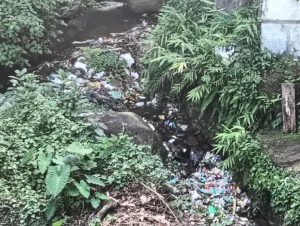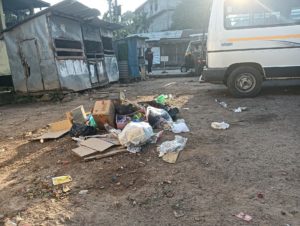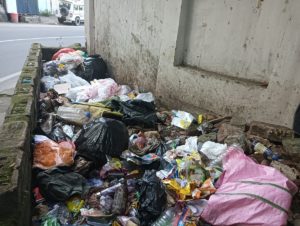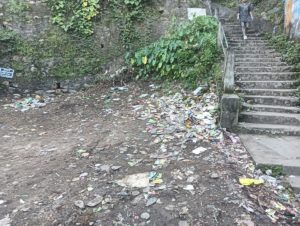By James D Sangma
 Once upon a time, Garo Hills stood as a paradise on earth, a true Eden Garden of God. Nestled in the heart of Meghalaya, this land was blessed with abundant forests, rich biodiversity, crystal-clear rivers, and a climate that nourished both people and nature. Garo Hills was not just a geographical location; it was a living testament of harmony between humanity and the environment. Elephants, tigers, monkeys, squirrels, wild cows, buffaloes, and countless species of birds and reptiles once roamed freely through the dense green jungles. The water was so pure that people could see the sand shimmering beneath the depths of the streams. Life was organic, sustainable, and deeply rooted in respect for nature.
Once upon a time, Garo Hills stood as a paradise on earth, a true Eden Garden of God. Nestled in the heart of Meghalaya, this land was blessed with abundant forests, rich biodiversity, crystal-clear rivers, and a climate that nourished both people and nature. Garo Hills was not just a geographical location; it was a living testament of harmony between humanity and the environment. Elephants, tigers, monkeys, squirrels, wild cows, buffaloes, and countless species of birds and reptiles once roamed freely through the dense green jungles. The water was so pure that people could see the sand shimmering beneath the depths of the streams. Life was organic, sustainable, and deeply rooted in respect for nature.
However, the current reality paints a grim picture. Garo Hills today is a shadow of its former self. Trees are vanishing, water bodies are polluted, animals are on the brink of extinction, and the environment is deteriorating rapidly. This essay explores the causes of ecological degradation, the carelessness of human activities, and how a collective movement can bring consciousness and restore the lost glory of the Garo Hills.
The Pristine Past
Before delving into the destruction, it is important to reflect on what Garo Hills once was. It was a landscape adorned with thick forests of teak, sal, and bamboo. The air was filled with the symphony of chirping birds, rustling leaves, and the roar of rivers down the hills. People lived off the land by consuming naturally grown fruits, vegetables, and roots. Fish, frogs, and fresh aquatic life enriched their diets.
 Children played by the rivers, women washed clothes in the streams, and men hunted selectively with rituals of gratitude. Elders used to throw seeds into the wild forests with a belief that they would return years later to reap its fruits. Every action was marked by care, wisdom, and sustainability.
Children played by the rivers, women washed clothes in the streams, and men hunted selectively with rituals of gratitude. Elders used to throw seeds into the wild forests with a belief that they would return years later to reap its fruits. Every action was marked by care, wisdom, and sustainability.
The forests were like cathedrals of green. The canopy overhead filtered sunlight into golden beams. Beneath them, medicinal plants, mushrooms, ferns, and orchids thrived. Many of the elders in Garo Hills lived long, healthy lives because they consumed food free from pesticides and drank from unpolluted natural sources. The bond between man and nature was sacred.
Seasonal fruits like wild mangoes, jackfruits, bananas, berries, and many varieties of fruits were harvested. Even the wildlife contributed to the ecosystem — elephants and other animals dispersed seeds through their dung, bees and butterflies pollinated flowers, and insects helped maintain soil health. Every creature had a role, and the forest thrived because of that interconnectedness.
The Downfall Begins
– Jhum Cultivation and Its Toll
Jhum cultivation, also known as slash-and-burn agriculture, was once a sustainable method practiced by indigenous communities. However, due to population pressure and reduction in fallow periods, this practice has become one of the major causes of environmental degradation.
When a patch of forest is cleared and burned to make way for crops, it destroys the soil’s fertility, emits carbon dioxide, and displaces wildlife. The topsoil, exposed to rain and wind, is washed away within a few years. What remains is barren land, incapable of supporting crops or trees.
 In earlier times, Jhum plots were left fallow for many years to regenerate. But now, with shorter cycles, nature has no time to heal. Farmers are left struggling to grow enough food, and in desperation, they clear new forest lands. It becomes a vicious cycle of destruction.
In earlier times, Jhum plots were left fallow for many years to regenerate. But now, with shorter cycles, nature has no time to heal. Farmers are left struggling to grow enough food, and in desperation, they clear new forest lands. It becomes a vicious cycle of destruction.
– Commercial Logging and Deforestation
Illegal and commercial logging is a growing concern. Timber merchants from outside the region collaborate with locals to cut down massive trees. These logs are transported out of the region, and what is left behind are erosion, heat, and drought.
The valuable hardwoods like teak and Sal take decades to mature, yet they are felled in a matter of minutes. People justify these actions by pointing to their economic needs. However, the short-term profits are quickly overshadowed by the long-term loss of biodiversity and climate regulation.
Without trees to hold the soil and attract rain, streams begin to dry, landslides become frequent, and rainfall patterns shift.
– Hunting and Killing of Wildlife
The once-diverse fauna of Garo Hills is declining. Elephants, which once roamed freely, are now seldom seen. Birds like hornbills, which were common, have retreated into remote forest patches. Daily hunting for bush meat has contributed to the decimation of wildlife.
 Tigers, deer, and pangolins have either become extinct locally or critically endangered. People no longer wait for the forest to give; they have begun to take what they can, when they can. This greed and ignorance are eating away at the roots of the ecosystem.
Tigers, deer, and pangolins have either become extinct locally or critically endangered. People no longer wait for the forest to give; they have begun to take what they can, when they can. This greed and ignorance are eating away at the roots of the ecosystem.
– Plastic Pollution and Domestic Waste
Plastic pollution is perhaps the most visible sign of neglect. Rivers are no longer pure. They are clogged with wrappers, sachets, bottles, and shopping bags. In villages and towns, garbage is dumped in open fields, near water sources, and along the roads.
The plastic chokes animals, blocks drainage, and pollutes water sources. Once beautiful rivers like Simsang and Ganol, Bugi, etc., are now struggling to breathe under layers of filth.
Domestic waste like diapers, sanitary pads, food wrappers, and electronic waste is often thrown directly into water bodies. The result is contamination, disease, and the death of aquatic life.
The Impact of Carelessness
– Water Scarcity and Heat waves
People in Garo Hills, once surrounded by rivers and rainfall, now suffer from severe water scarcity. Women and children walk for miles to fetch a bucket of water. Wells have dried. Streams have vanished. People must depend on tankers or bottled water.
The summer heat has become unbearable. The shade of the forest is gone. Houses feel like ovens. Animals die of thirst. Birds no longer sing in the afternoons. The cycle of life has been broken.
– Extinction of Flora and Fauna
Many medicinal herbs are now lost forever. Trees that once cured fever, wounds, or infections have disappeared. Birds like parrots, doves, and cuckoos are rare. The biodiversity of Garo Hills, once a treasure trove, is now endangered.
With fewer pollinators like bees and butterflies, even agriculture is suffering. People are growing less food. The cost of vegetables has increased. Hunger and poverty are rising.
– Soil Erosion and Landslides
Without tree roots to bind the soil, entire hillsides collapse during the rains. Landslides kill people, destroy homes, and block roads. Every monsoon, fear grips the hearts of the people.
Villages on slopes are the most affected. In some places, farmlands have turned into gravel beds. Farmers abandon their lands and migrate to cities.
– Health Issues and Diseases
Unclean water has led to outbreaks of typhoid, cholera, and dysentery. The burning of plastic releases toxic gases, causing asthma and lung diseases. Garbage heaps attracts flies, mosquitoes, and rats. Children fall sick more often. Hospitals are overcrowded.
The once-healthy population of Garo Hills now battles diseases that were unheard of in the past.
Awakening the Consciousness
– Environmental Education
Children are the torchbearers of change, and they must be equipped with knowledge about the environment from their earliest years. Environmental education should be introduced as a core subject in all schools. Local flora and fauna, the importance of biodiversity, and the dangers of deforestation and pollution must be taught in relatable ways.
Educational institutions should organize eco-camps, nature walks, tree-planting drives, and recycling workshops. Traditional knowledge from elders about medicinal plants, sustainable farming, and forest management must be integrated into the curriculum.
– Community Awareness Campaigns
Community awareness programs should be conducted in every village. Public meetings, storytelling sessions, and visual demonstrations can help people understand the damage caused by careless actions and the benefits of restoration.
Special emphasis must be placed on the role of every individual—be it a farmer, homemaker, student, or businessman.
– Role of Religious Institutions
Churches and religious groups wield great influence in the lives of the Garo people. Sermons, pastoral letters, and religious gatherings must include messages on environmental stewardship.
Christian teachings about creation care, compassion for animals, and responsibility towards God’s earth can be powerful tools. Special days like Earth Day or Environment Sunday can be celebrated with prayers, tree-planting, and cleaning drives.
– Use of Media and Social Platforms
Television, radio, newspapers, and social media can help reach a wider audience. Short films, documentaries, and awareness ads in local dialects can make a huge difference.
Successful stories—like villages that turned garbage dumps into gardens or communities that revived dying rivers—should be promoted.
The Vision for a New Eden
Imagine a Garo Hills where forests are alive again, rivers run crystal clear, birds return with their sweet songs, and people live in harmony with nature. Schools teach children how to plant and protect, churches conduct prayers under the shade of trees, and elders once again throw seeds into the wild with joy.
This is not a fantasy. It is a possible future—if every individual, every family; every leader decides to take responsibility today.
Let Garo Hills rise again. Let it be the Eden Garden of God once more.
The degradation of Garo Hills is a human-made tragedy—but it need not be the end of the story. The people of Garo Hills still hold the key to their future. Through education, awareness, sustainable practices, and strong governance, this land can be revived.
Let us not wait for outsiders or authorities alone to bring change. Let us rise as one people, one land, and one mission. Let us teach our children that the earth is sacred, that water is life, and that forests are temples.
May Garo Hills bloom again. May the rivers run clear. May our homes be cool under trees planted with love. May we restore the Eden Garden of God in our time, for our children, and for generations to come.
(The author is a resident of Ruganokat village of Garo Hills, and spends his time observing life around him with a thirst for real-life experiences and the silent emotions of ordinary people.)



